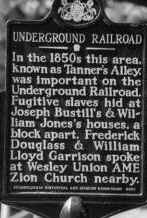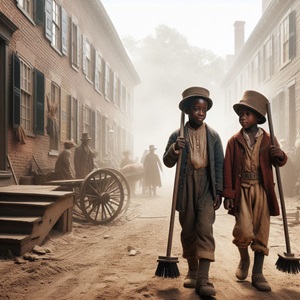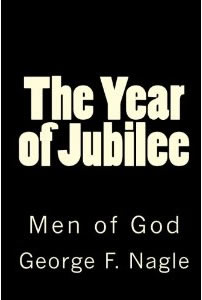
Study Areas
Rev. Edward E. Bennett
Businessman and Community Leader
Sometime about 1815 Edward E. Bennett arrived in Harrisburg from his native Carlisle at the age of twelve. Accounts of his early life are sparse. He may have spent his early years in the borough working in a white household. If so, this would explain why he does not appear on the 1821 Registry of free Blacks in town. Sometime in the 1830s he began a chimney sweeping service in competition with other local African American businessmen Ezekiel Carter and John Battis. The growing town had plenty of chimneys to keep clean, in the years before coal became a common fuel in town, and Bennett's business prospered despite his late arrival on the scene. Not only was Edward Bennett able to successfully market his services in a small town with two other chimney sweeping businesses, but he was also able to eclipse both Carter and Battis in the size of his operation, soon becoming the overseer of the town's largest corps of young boys engaged as sweeps. Bennett took his operation beyond the town limits, and marketed his services to the residents living along the farm lanes and country roads that radiated out from Harrisburg.

Edward Bennett was a young man, clearly ambitious and smart, and he soon attracted the eye of Mary Ann Richards, the daughter of a local matriarch, Judy Richards. Edward and Mary Ann married, and the newlyweds settled in a house near the bride's mother, near Third and Mulberry streets. This area had been developing slowly as a mixed race neighborhood, since before the 1820s, and its "proprietress," or the person to whom local inhabitants went to get things done or to settle disputes, was Judy Richards. So important was Richards to the informal governance of this neighborhood that the area, squeezed into the southern edge of Harrisburg, became known as Judytown or Judy's Town. It was from his home in Judy's Town that Edward Bennett managed his expanding army of young African American chimneysweeps, who he dispatched on their rounds early every morning into the streets of Harrisburg and out into the townships.
About the time that Edward and Mary Ann Bennett settled into their home on Mulberry Street and began to establish their business as a local institution there, another important institution moved into that same neighborhood. On 20 August 1829, the Wesley Union Church was organized in a small log building at the corner of Third and Mulberry streets. The organizers were Elder Jacob D. Richardson, originally from York, Deacon David Stevens, and Brother Matthias Dorsey. At the A.M.E. conference in Philadelphia the following year, Reverend Stevens was ordained an elder and given charge of the Harrisburg Circuit. The establishment of the first African American church in Judy's Town firmly fixed that neighborhood as an important center of African American social and spiritual life in the borough. This, in turn, led more and more African Americans to settle nearby, as the old rooming houses on Strawberry Alley and Market Street were becoming overcrowded. In addition, the development of properties by white owners was beginning to creep east on Market, slowly squeezing out the black families who had been only renting their properties. Faced with having to relocate in town, many chose to move south to the Third and Mulberry neighborhood. The Bennetts became heavily involved with the new church and rose rapidly in prestige and influence in their community.
Spiritual Leader and Underground Railroad Conductor
With regard to that influence, a local historian recalled that Judystown
was dominated by the Rev. Edward Bennett, who was also known, probably because of his forceful ways, as "King" Bennett. He was a negro of gigantic stature, a good citizen and he was firm on law and order. Almost everyone in the section belonged to his denomiation and those who did not were under his influence, which was wide awake and energetic, from all accounts. He lived at 139 South Third street and was literally guide, counsellor and friend to the colored folks of the neighborhood and the man to whom many a Harrisburg man and woman went for a cook or upstairs maid.
Judystown was Harrisburg’s first distinct African American community, and as such was probably the first place in town in which widespread organized Underground Railroad activity took place. It was the spiritual center for Harrisburg’s African American population, housing the Wesley Union A.M.E. church from 1829 until the church relocated several blocks away in 1839. Bennett, found in the 1850 census, was a church leader, listing his occupation in 1850 as "preacher." His neighbors in Judystown, in 1850, included George Galbraith, an ordained minister in the A.M.E. church, and David Stevens, a young preacher who would serve as a chaplain to African American regiments during the Civil War. Edward Bennett’s Underground Railroad involvement has been cited by nineteenth century historians William Henry Egle and George H. Morgan. The church itself was cited by numerous African American residents as an Underground Railroad station.
Bennett was an active anti-slavery activist from the start. As early as 1825 he was one of the local African American men arrested for participating in Harrisburg's violent attempted rescue of a fugitive slave in 1825. As Wesley Union A.M.E. assumed a central role in local Underground Railroad operations, it was only natural that the Bennetts, church leaders, either had a hand in promoting that role or assumed activist roles themselves, or both. A news article in 1900 characterized Bennett as a man "who was in his time the commander-in-chief of a corps of chimney sweeps, and was one of the principal directors and concealers of the fugitive slave on his way to the Northland from the taskmaster's fields in Maryland and Virginia."
Notes
The marriage of Edward and Mary Ann Richards probably occurred between 1820 and 1830. In 1820, Mary Richards is enumerated in the 1820 census as a free person of color head of household consisting of two FPOC women. No males are enumerated in her household. The 1830 census includes the Edward Bennett household, consisting of one male adult 10-24, one female age 24-36, and one female child below age 10, all of which corresponds roughly with their ages. According to published biographical information, Edward was born on March 27, 1803, so the slash mark recording him should have been in the male, 24-36 years column. The census taker either recorded his age incorrectly, or he was possibly younger than reported. Mary Ann was several years older than Edward and appears to have been recorded correctly, based upon her reported age at her death.
Edward E. Bennett moved to Washington DC in the last few years of his life. His death on August 13, 1887 was reported in the Washington Bee on 20 August 1887 in a lengthy "In Memoriam," which included the praise "No man was more respected in this city than Rev. Bennett."
Sources
- Population Schedules of the Fourth Census of the United States: 1820. Roll 102; Pennsylvania; Volume 7. Pennsylvania, Dauphin County. Microfilm in the Pennsylvania State Archives, Harrisburg, PA.
- Population Schedules of the Fifth Census of the United States: 1830. Pennsylvania, Dauphin County. Microfilm in the Pennsylvania State Archives, Harrisburg, PA.
- "Population Schedules of the Seventh Census of the United States, 1850, rolls 774 and 775, Pennsylvania, Dauphin County." National Archives Microfilm #432
- Harrisburg Telegraph, 18 February 1874
- Harrisburg Telegraph, 22 August 1882
- The Washington Bee, 20 August 1887
- Harrisburg Telegraph, 2 June 1897
- Harrisburg Telegraph, 12 May 1900
Now Available on this site
The Year of Jubilee
Vol. 1: Men of God and Vol. 2: Men of Muscle
by George F. Nagle
Both volumes of the Afrolumens book are now available on this website. Click the link to read.
The Year of Jubilee is the story of Harrisburg'g free African American community, from the era of colonialism and slavery to hard-won freedom.
 Volume
One, Men of God, covers the turbulent beginnings of this community,
from Hercules and the first slaves, the growth of slavery in central
Pennsylvania, the Harrisburg area slave plantations, early runaway
slaves, to the birth of a free black community. Men of God is a detailed
history of Harrisburg's first black entrepreneurs, the early black
churches, the first black neighborhoods, and the maturing of the social
institutions that supported this vibrant community.
Volume
One, Men of God, covers the turbulent beginnings of this community,
from Hercules and the first slaves, the growth of slavery in central
Pennsylvania, the Harrisburg area slave plantations, early runaway
slaves, to the birth of a free black community. Men of God is a detailed
history of Harrisburg's first black entrepreneurs, the early black
churches, the first black neighborhoods, and the maturing of the social
institutions that supported this vibrant community.
It includes an extensive examination of state and federal laws governing slave ownership and the recovery of runaway slaves, the growth of the colonization movement, anti-colonization efforts, anti-slavery, abolitionism and radical abolitionism. It concludes with the complex relationship between Harrisburg's black and white abolitionists, and details the efforts and activities of each group as they worked separately at first, then learned to cooperate in fighting against slavery. Read it here.
Non-fiction, history. 607 pages, softcover.
 Volume
Two, Men of Muscle takes the story from 1850 and the Fugitive Slave
Law of 1850, through the explosive 1850s to the coming of Civil War
to central Pennsylvania. In this volume, Harrisburg's African American
community weathers kidnappings, raids, riots, plots, murders, intimidation,
and the coming of war. Caught between hostile Union soldiers and deadly
Confederate soldiers, they ultimately had to choose between fleeing
or fighting. This is the story of that choice.
Volume
Two, Men of Muscle takes the story from 1850 and the Fugitive Slave
Law of 1850, through the explosive 1850s to the coming of Civil War
to central Pennsylvania. In this volume, Harrisburg's African American
community weathers kidnappings, raids, riots, plots, murders, intimidation,
and the coming of war. Caught between hostile Union soldiers and deadly
Confederate soldiers, they ultimately had to choose between fleeing
or fighting. This is the story of that choice.
Non-fiction, history. 630 pages, softcover.

